Top News
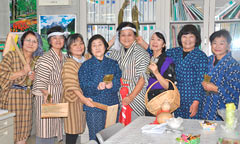
January 24, 2014 Koei Chibana, correspondent of Ryukyu Shimpo
Yonabaru Town Culture Association Children Culture Club has been working to promote familiarization of Shimakutuba, the endangered Okinawan language to children. The organization formed a Shimakutuba drama group “Yonabaru ObaQ.”
On January 17, Yonabaru Town Kindergarten held a parent-child craft event for muchi or traditional Okinawan rice cake. The group performed a picture-story show and a skit about the origin of Uni Muchi for the first time. Thrilling the children and young parents, the group received a favorable reception. The group consists of eight women, including the 85-year-old leader of the club Setsuko Chinen. Led by Chinen and Sumiko Yabiku, a member of Town’s Education and Children Committee, the group has been teaching the language at elementary schools and kindergartens. They have been promoting Shimakutuba.
Yabiku wrote “Folklore: Uni Muchi” in Shimakutuba. Rieko Uehara recounted a story and other members performed it with humor. The principal of the kindergarten Tsunemasa Kuwae said, “The children used to listen occasionally to Shimakutuba stories, so their skit was easy to understand.” Chinen said, “Because we are a group of seniors, we named it ‘Oba (Grandma in Okinawan dialect) Q’. We will continue to practice and promote the language.”
(English translation by T&CT and Megumi Chibana)
Go to Japanese
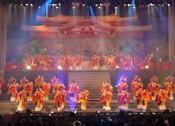
January 26, 2014 Ryukyu Shimpo
An event introducing Okinawan traditional arts started at the Okinawa Convention Center in Ginowan on January 25. The organizer has held the event for 31 consecutive years in Okinawa. The four-day event has attracted about 11,000 people by January 26.
The splendid stage and performances entertained the spectators.
Designing the stage in the image of the Dragon Palace, the stage director created the set copying a seabed. Mixing lighting with music, the director displayed Okinawan traditional arts. More than 800 people took part in the event.
Yuko Sakuma who attended the event with her family members from Tomigusuku City, said, “This is the third time that we have attended the event. The dragon dance performed at the beginning of the event was overwhelming. We enjoyed it. We want to visit next year too.”
(English translation by T&CT)
Go to Japanese
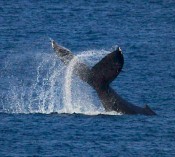
January 22, 2014 Katsuyoshi Oshiro, correspondent of Ryukyu Shimpo
In the morning of January 11, two humpback whales swam 200 meters off the coast of the Ginama district of Kunigami Village. They moved slowly, occasionally shooting up a spray of water and slamming their tail fins into the surface.
In summer, the whales stay in waters in high latitudes such the sea near the Aleutian Islands. In the winter, they migrate to warmer waters in lower latitudes in order to breed. The whales appear in the waters around Kunigami from January to March every year.
February is the best time to watch whales off Cape Hedo and other areas.
Masakazu Kudaka, who came to do some whale watching, said, “The whales migrate to the waters around Okinawa to breed every winter. You can watch them around here for a week.”
Natsuko Kudaka, who watched the whales with Masakazu, said, “I saw the whales for the first time since I was in elementary school. They shot up a spray of water and slammed their tail fins to the surface, which was impressive.”
On January 1 and 2, people saw the whales off Cape Hedo.
(English translation by T&CT)
Go to Japanese
January 25, 2014 Ryukyu Shimpo
The Okinawa Defense Bureau investigated the habitat of the endangered species the dugong from an aircraft over 35 days between September 2011 to January 2013 in preparation for moving the US Marine Corps Air Station Futenma to Henoko, Nago. They confirmed the presence of dugongs 31 times in 29 days in the waters off Kayo on the north side of Henoko, and in the waters of Kori Island off the west coast.
The defense bureau has observed the dugongs off Henoko. It was found that the dugongs’ activity covered a wide range of sea around the main island of Okinawa. The Okinawa Prefectural Government revealed the documents in response to a request from the media, including the Ryukyu Shimpo, based on the Freedom of Information Act. The investigation report on the dugong was included in letters exchanged between the Okinawa Prefectural Government and the defense bureau on the landfill application. According to the documents, which the defense bureau submitted to the Okinawa Prefectural Government, they found dugongs 15 times in the waters off Kayo, four times off Kori in a wide-area habitat survey. They also observed the animals 12 times off Kayo by the survey within the specified area.
The defense bureau speculates that two of the three dugongs they found are parent and calf. The calf has been independent from its parents since May 2008 and moves around the wide area from the west to the east coast. The defense bureau confirmed evidence of traces eaten by dugongs three times in the Henoko area during the period in which they investigated 11 times. However, the number of times that dugongs have eaten in the Henoko area was much less than that in Kayo. Therefore, the defense bureau estimates that the dugongs used the seagrass beds in the Henoko area within the limited use.
(English translation by T&CT)
Go to Japanese
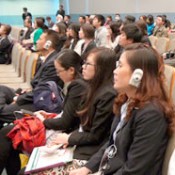
January 17, 2014 Ryukyu Shimpo
On January 16, the ASEAN-Japan Tourism Exchange Convention, which seeks to attract tourists from ASEAN countries to Japan and Okinawa was held in Ginowan City. People related to the tourism industry and the government in Japan held a panel discussion on the challenges and visions to promote ASEAN-Japan tourism exchange. They pointed out that it is necessary to start promotions by regions and to launch charter flights to attract more customers.
The Director-General of the Department of Culture, Tourism and Sports of Okinawa, Seijun Wakugawa, said, “The number of tourists from ASEAN to Okinawa between April and November 2013 was about 50,000. This is more than the annual number of tourists in 2012. The number has rapidly increased.”
The Assistant Director of the Department of Tourism and Exchange of ASEAN-Japan Center, Zuiho Kanda, said, “Japan has become a popular destination among ASEAN countries. However, Okinawa is less popular than Tokyo and Osaka. Its accessibility is inconvenient.” She went on to say, “Okinawa should increase charter flights in the future and look to attract tourists using low-cost carriers.”
Jiro Mitsumoto, the president of Asahi Travel Service Pvt. Ltd joined from Thailand. He said that Okinawa and Thailand had many similarities. Mitsumoto continued that Okinawa needs to promote its various tourist spots like Shuri Castle efficiently.
(English translation by T&CT and Lima Tokumori)
Go to Japanese
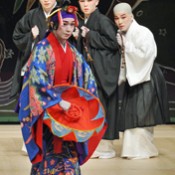
January 19, 2014 Ryukyu Shimpo
Marking the 10th anniversary of its opening, the National Theater Okinawa held commemoration ceremony and celebration performance in Urasoe on January 18.
Many people involved celebrated this occasion for the theater that has been growing as the Hall of Fame for Okinawan traditional arts. They prayed for its further development. Ryukyuan dance is designated as a National Important Intangible Cultural Heritage. A practitioner of the dance, who has been promoting the Okinawa traditional arts since the war, started the event by performing the ceremonial dance called Kajade. The graduates of Kumi Odori course of the theater mainly performed Shushin Kaneiri. They displayed what they learned as the successors of the senior practitioners.
Okinawa vice Governor Kurayoshi Takara who is the executive head of the foundation managing the theater, delivered a speech. He said, “While mainly focusing on Kumi Odori performances, the theater has been putting on display performing arts of Okinawa, the main islands of Japan and Asia. They have also been working on new performing arts. The number of the audience increases. The graduates become successful. Working with the cultural exchange projects carried out by the prefectural government, I would like the theater to be the hub for traditional arts and tourism.”
Okinawa Governor Hirokazu Nakaima said, “Based in the theater, we will work on various policies for its sustainable development while preserving and taking over the traditional arts, which are the properties that Okinawan people are proud of.”
The Japanese Prince and Princess once visited the theater.
(English translation by T&CT)
Go to Japanese

January 17, 2014 Ryukyu Shimpo
Sunflowers are in full bloom in a 10,000-square-meter field behind Kitanakagusuku Junior High School. On January 18, the 6th Sunflower Event in Kitanakagusuku started, and will run until February 2.
The sunflowers, which farmers planted for use as fertilizer, have attracted the attention of many people. It has become a popular event every January.
The villagers, chiefly the residents of Ogido and Kitanakagusuku, planted the flowers last October. Children from kindergartens in the village also took part in planting seeds.
Tsugio Higa, a volunteer who takes care of the sunflowers, said, “We open up booths this year and will hold a running race for elementary school pupils in the sunflower field.”
(English translation by T&CT, Hitomi Shinzato)
Go to Japanese
January 20, 2014 Ryukyu Shimpo
In the Nago mayoral election, the incumbent Susumu Inamine, who rejects moving U.S. Marine Corps Air Station Futenma to Henoko, Nago, won a landslide victory in his second term against Bunshin Suematsu, a former Okinawa prefectural assembly member who backs the government’s relocation plan. In the election, the residents showed clearly their desire to reject the Henoko plan. This is a historic declaration of the right to self-determination, in which the residents asserted that they would decide the future of the region for themselves. We should accept seriously their decision to refuse the base. Both the governments of Japan and the United States should abandon the Henoko plan, and respect democracy and the right to self-determination of the Nago people. Moving the U.S. Marines from Futenma outside Okinawa and closing the base is the quicker way to reduce the potential risk for the community.
Election result indicates no-confidence in Okinawa Governor
We would like to express our sincere respect to the residents who voted with pride, having a vision of sustainable, peaceful and prosperous development of Nago for their children and grandchildren.
Mayor Inamine has consistently insisted that he would not permit the government to build the new base in Henoko to protect the children and the natural environment. Believing his determination, it was likely that the electorate of Nago would entrust the development of the city, the future of their children and themselves to him.
The result of the election should be seen as a strong no-confidence vote against Okinawa Governor Hirokazu Nakaima, who canceled his election pledge in which he promised to relocate the Futenma base outside the prefecture and approved the Henoko landfill application from the central government at the end of last year. Governor Nakaima should take the result of the election seriously and withdraw the landfill approval. We urge the governor to ask the central government to abandon the planned relocation of the Futenma base within the prefecture with support from the public in Okinawa, instead of following the colonial policy by the Abe administration, which is trying to divide Okinawan people. If the governor tries to cling to the Henoko plan by the central government, he will betray the Okinawan people. If so, he should resign from his post.
The five LDP Diet members from Okinawa, the LDP prefectural chapter members and some heads of the municipalities who withdrew their election pledges should also go back to their promises.
Since the agreement in 1996, the people in Nago have been swayed by whether they accept or reject the Henoko plan. However, the residents rejected the sacrifice that both the governments of Japan and the United States required. This represents a milestone for the people who will be able to be proud of it into the future. During the campaign, the Liberal Democratic Party asserted that they would settle the relocation issue in this election. If so, they should abandon the Henoko plan. We would like the 47, 000 voters to be single-minded in their efforts to develop the Yambaru community which has beautiful scenery, abundant natural and cultural resources.
If the governments bulldoze their way to build the new base in the small islands of Okinawa, it will become a heavy burden on the residents, including human rights violations and a growing common threat to life and property. Chimu gurisa in the Okinawan dialect means sharing the sufferings of others. We have respected the old Okinawan spirit of this expression. It is unbearable for the people of Okinawa to build the military base within the prefecture.
President Obama should admit democracy in Okinawa
The U.S. Marines have deployed 24 Osprey aircraft to Futenma base. This move has put a serious burden on the residents. We are not going to allow a situation like that to continue.
According to an opinion survey conducted by the Ryukyu Shimpo, immediately after the Okinawa Governor approved the landfill, 73.5 percent of all respondents asked for the Futenma base to be closed unconditionally and relocated outside the prefecture or overseas. Building a base within Okinawa to replace U.S. Marine Corps Air Station Futenma is unacceptable. This is the will of the people of Okinawa.
We need support from the people who live in the mainland of Japan to close Futenma base. We don’t want them to sit back and wait for the issue to be resolved in some other way.
Some diplomacy and security experts in the United States discuss the plan B, instead of the Henoko relocation plan that they used to promote.
Western intellectuals, including Nobel Prize winners, also oppose the Henoko relocation. The world’s conscience keepers support the Okinawan people.
Japan and the United States should understand the changing realities surrounding the Futenma issue. They accomplished the Okinawa reversion in 1972, a historic achievement between two countries through the diplomatic negotiation. As long as they set their minds to it, they should be able to close and remove the Futenma base, which occupies about 480 hectares. The Okinawan people have expressed their rejection to the Henoko plan by using the democratic procedures of voting in the national elections, the gubernatorial race, the elections for prefectural assembly members and the municipal mayor elections. The Henoko plan has never once had a majority of Okinawans in favor of it in opinion surveys. Prime Minister Shinzo Abe and President Obama said that they would pursue international diplomacy based on the fundamental values of freedom, democracy, basic human rights and the rule of law. If so, we want them to apply democracy in Okinawa. It will be impossible to implement the Henoko plan that ignores the will of the people. It is time for the government to cancel the planned Futenma relocation.
(English translation by T&CT)
Go to Japanese
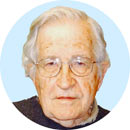
January 17, 2014 Ryukyu Shimpo
Linguist Noam Chomsky, a leading international scholar, peace advocate and artist who released a statement opposing the construction of a new US military base within Okinawa, contributed a message to the Ryukyu Shimpo on January 16. The author and activist commented in his message: “They [Okinawans] have every right to seek a future in which they will be the masters of their own fate, not sacrificed in the interests of others, a future in which they will be able to make their own independent and valuable contribution to bringing about a more just and peaceful world.”
People in many parts of the world reacted favorably to the statement supporting the Okinawan struggle. The international media, including the RT (a worldwide Russian TV network), reported the statement.
Chomsky is a linguistics professor who is outspoken in his criticism of U.S. foreign policy, which he characterizes as hegemonic. He is an influential author of works dealing with social issues and politics and was selected among the world’s top public intellectuals in 2005.
Referring to the statement, he said, “I was pleased to be invited to participate in the international campaign to support the courageous struggle of the people of Okinawa to free themselves from the US military bases, which impose the severe burden of military occupation, harm the lives of the population and the environment, and constantly carry great dangers.” He will pay attention to the Okinawa problem.
The 29 initial signers of the statement include Academy Award-winning filmmaker Oliver Stone and Mairead Maguire, who was awarded the Nobel Peace Prize for her work for peace and a nonviolent solution to the conflict in Northern Ireland, as well as Chomsky.
(English translation by T&CT)
Go to Japanese
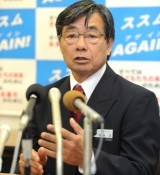
January 20, 2014 Ryukyu Shimpo
Winning the Nago mayoral election on January 19, reelected Nago Mayor Susumu Inamine held a press conference in the morning of the next day. The focal issue of the election was to move U.S. Marine Corps Air Station Futenma to the Henoko district of Nago. In the office of his support group in Onaka, Inamine said, “A day after winning the election, I will do my best to stand strong against what will come.” He showed his determination to work on preventing the Henoko relocation.
If the Japanese government forces through the plan to build a new U.S. military base, Inamine intends to exercise his authority to prevent it. Inamine claimed, “Even though the central government carries out the survey for the reclamation, I will exercise my authority as the mayor, including the right to manage Henoko Fishing Port to prevent the plan.”
(English translation by T&CT)
Go to Japanese
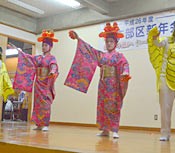
January 17, 2014 Ryukyu Shimpo
On January 11 at the Motobu District of Haebaru Town, a traditional performance of “Haberu moui” was performed at a New Year’s party held at the Children’s Hall for the first time in 64 years since 1950. Many people visited the hall to see the revival of the traditional performance. Residents applauded and cheered the junior high school and high school students who performed the dance.
Haberu moui is a courtship dance in which two women perform as flowers and two men play the part of butterflies. After finding pictures of the 1950 dance contest two years ago, residents of the district have prepared to revive the dance.
Senior residents who performed in 1950 taught the students the dance. Two male students performed the butterfly dance last September.
Eighty-two-year-old Seiji Nohara who coached them, said, “Their dance is not perfect yet, but it is much better than at the beginning. If there are more chances to perform, they will do better.”
Nana Yakabi who played a flower said, “I have practiced Ryukyuan dance, but it was difficult because I need to position my hand at a different height. I was nervous in the beginning because I had to perform the traditional dance of the district.”
(English translation by T&CT and Megumi Chibana)
Go to Japanese









 Webcam(Kokusai Street)
Webcam(Kokusai Street)


